You are using an out of date browser. It may not display this or other websites correctly.
You should upgrade or use an alternative browser.
You should upgrade or use an alternative browser.
Canon 100-400 L II vs Sigma 150-600 Contemporary
- Thread starter Talys
- Start date
AlanF said:The fantastic photos by Piovanil plus all the others in his Flickr are nearly all of perched birds or static animals in good light. The 150-600mm C is superb for those conditions, and I take mine with me for trips under such conditions. But, there other circumstances where it isn't going to be much good - namely poor light. I posted questions quoted below of what lenses to take with me to Borneo, including my 150-600mm C or 400mm DO II. At the last minute, I unpacked the Sigma and took the 400mm f/4, which saved the whole trip. Nearly all the photos I took were at dawn or dusk or at night or in the rain forest. I was shooting at f/4 and iso 6400 most of the time. The 100-400mm II was being used by wife at doubly long shutter speeds hand held. The 150-600mm at f/6.3 and its poorer IS (about a stop less in my experience) would have been a disaster. Also, on a recent trip to film puffins in flight I needed exceptionally fast AF, which the Sigma is not good at.
It's nice to have a choice of lenses, but if you have only one, then the Sigma is excellent for much, but not all of the time.
AlanF said:I know what gear and lenses to take on a South African safari or a bird photography holiday, but my wife and I have a trip of a lifetime coming up at the end of August - Sabah in Borneo. The itinerary is:
KOTA KINABALU - Wet land, mud-flats and open country habitats.
SEPILOK – Lowland old secondary forest habitat.
GOMOTONG CAVES – Limestone habitat.
KINABATANGAN-BILIT – Riverine and flood plains habitat.
TABIN WILDLIFE RESERVE – Old secondary and primary rainforest habitat.
KINABALU PARK - Pristine montane rainforest.
PORING HOT SPRINGS – Upper hill forest
"Primary focus of this tour is on birds but we will also look at other natural history aspects including mammals (Orang Utan, Bornean Pgymy Elephant, Proboscis Monkey, Red-leaf Langur, Bornean Gibbon, Western Tasier, Clouded Leopard, Mouse-deers, Otters, Flying Squirels, Flying Lemus, Wild Cats, etc. etc. with a strong emphasis on finding wild Orang Utans), reptiles (Salt-water Crocodiles, Flying Lizards, Flying Snakes, etc. etc.), amphibians (Wallace’s Flying Frog, etc. etc) and interesting plants (Rafflesia, Orchids, Nepenthes, etc. Etc.
There will a flight from Kuala Lumpur to Sabah with restricted cabin luggage - 7 kg per person with the rest in the hold. The possible gear is taken from 5DSR, 5DIV, 7DII and M5, with 400mm DO II, 150-600mm C and Canon 100-400mm II. My initial thoughts are to take the 5DSR + Sigma for me, the 5DIV + 100-400mm II for my wife, throw the 7DII as a spare in the hold baggage, and slip in the M5 with a couple of lenses for scenery.
You really do need zoom lenses, but, I'll miss the 400mm DO II. I'd even be tempted to leave the 150-600 and get a Sigma 100-400 for the 7DII and throw them in the suitcase. What would you experienced hands recommend? (Should I even consider my 300mm/2.8?). Maybe having the prime and sharing the 100-400mm II?
Yes.. of course an f4 lens with a full frame is a lot better... the 400 f4 DO II is a great option. Sharp, fast enough at f4, with a good IS and very light... but cost almost 6 times more than the Sigma!. Also it is a fixed lens... I've got a 400 f5.6L for a long long time, and it is great. Very fast focusing and ideal for BIF. I used to take more of those pictures when I used that lens.
But the main reason I bought the Sigma was that I ended up cropping all my pictures taken with the 400. I was really eager to learn to compose into the camera and get rid of the cropping if possible, or at least minimize it.
So I bought the Sigma 150-600C as a tool to learn, to improve my composition. Then I use it... and everything changed for me. The 400 is inside its box since then, almost two years now.
When I went to Costa Rica in past January, I was very worried about the jungle and the lack of light... to use an f6.3 lens and with a 7D in which I didnt trusted beyond ISO 800 was crazy... but I've already had a chance to test it before, together with my flashes into the Yungas, almost same environment... very dark and constantly under the rain.
And also I had my secret weapon... yes, the monopod and tripod!.
So it would have been nice to had a 300 f2.8 IS II... but just could not afford it... My travel companions carried big guns with them, Canon 200-400, Canon 500 f4L IS II, 1Dx II, 5Ds... but in the end I dont feel that they've got more and lot better pictures than myself. At 960 mm the DOF is very thin, especially from 3 meters, so f7.1 is usually needed anyway.
If you look at the parameters in some of my pictures you will see that were taken with very bad light... knowing the behavior of your subject helps to make the difference. When it will stop, where and for how long... and of course being able to use that moment to take the picture.
Still, I would recommend an f2.8 any day, if you can afford it and carry it with you!. That is the reason I bought my 70-200 f2.8 IS. And I plan to use it as a complement to my Sigma when the subject is big and close and the light is bad. I'm planning a trip to Africa myself, and two cameras with the 70-200 and a 150-600 for now is my winning combination.
An example... this Quetzal male stood only for 3 seconds in the open and fixed in that position. It was really dark, at almost 8 pm and with spray rain. The parameters, 373 mm - 1/80 - f7.1 - ISO 1250 with monopod.
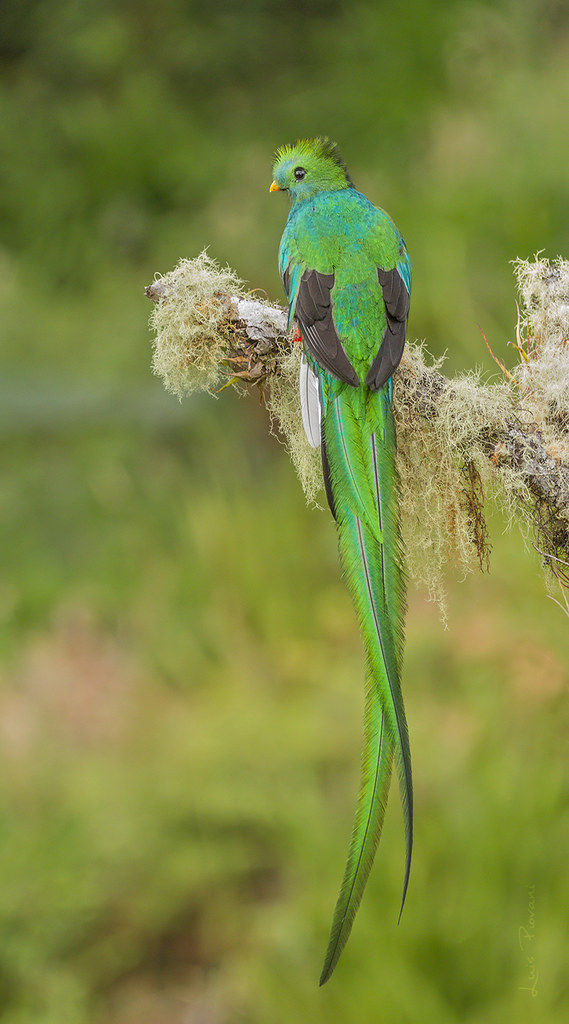
Want to know what happened on the 4th second when it moved? Not one of my best moments!
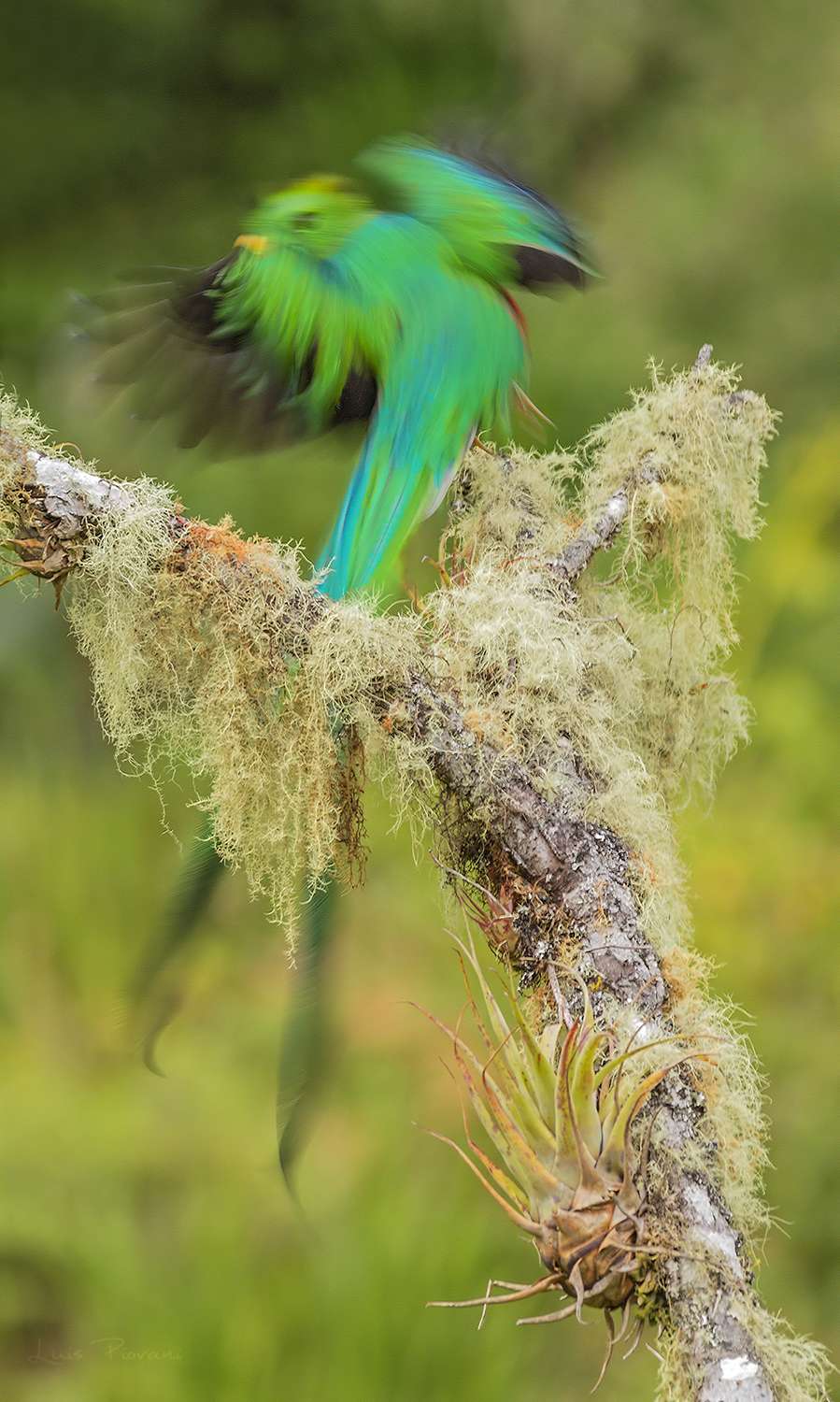
So yes, f6.3 is very bad... and the Sigma autofocus may not be quick enough for you... even the picture quality is lacking under some conditions. But knowing the limits give you a chance to work around them to get the better possible result with the minimum amount of money. Of course, if someone is eager to donate me a 200-400, a 300 f2.8 IS II or a 500 f4 IS II I could easily put my Sigma into it's box and never use it again!. Until then, I'll try to make the best I can with what I have!
Upvote
0
There are problems with f/2.8s. The 300mm/2.8 II and the 400mm/2.8 II are the sharpest lenses on the block. I have just sold my 300mm/2.8 II as I haven't used it since buying the 400mm DO II, and Art Morris says in his blog that the price of used 300mms has dropped since the 400mm II has come out as birders prefer it. 300mm is too short.
It might be a surprise, but there is little advantage in light-gathering f-stop using a 300mm at f/2.8 compared with a 400mm at f/4 when you are cropping. You get nearly as much light going through the 400mm/4 as the 300mm/2.8 as they have similar sized front elements. If you double the iso with the 400mm to get the same shutter speed as an f/2.8, and then downsize 1.4x, you end up with very similar signal to noise.
The 400mm/2.8 II is too heavy to hand hold for birds in flight. On my puffins in flight trip, I was able to swing around quickly with my 5DIV and 400mm/4 and get shot after shot whereas the person next to me with a 1DX and 400/2.8 on a tripod was too slow. For static shots, the 400/2.8 was the winner.
It might be a surprise, but there is little advantage in light-gathering f-stop using a 300mm at f/2.8 compared with a 400mm at f/4 when you are cropping. You get nearly as much light going through the 400mm/4 as the 300mm/2.8 as they have similar sized front elements. If you double the iso with the 400mm to get the same shutter speed as an f/2.8, and then downsize 1.4x, you end up with very similar signal to noise.
The 400mm/2.8 II is too heavy to hand hold for birds in flight. On my puffins in flight trip, I was able to swing around quickly with my 5DIV and 400mm/4 and get shot after shot whereas the person next to me with a 1DX and 400/2.8 on a tripod was too slow. For static shots, the 400/2.8 was the winner.
Upvote
0
tomscott
Photographer & Graphic Designer
TBH for Africa I didnt need my 70-200mm I wasnt there for 2 weeks was there 3 months and came across pretty much all situations you would find yourself light wise.
Many people think you need the biggest lenses you dont. Animals except a few are all within framing with 600mm. Birds are always a difficult one but again I had no issues except small birds like bee-eaters or lilac breasted rollers etc but they are everywhere so its not like you have to go far to find them.
I didnt find myself needing the 2.8, and its far too shallow for most subjects. Plus you have to think about the weight. The nice thing about the 70-200mm is you can put a 1.4 and get a good 280 F4 or 450 F4 on crop, I used to shoot primarily with the 70-200mm with a 2x and got some of my favourite shots with it.
The 100-400mm is just the best of both for me. Want 600mm stick a 7D on it want better IQ at lower light stick it on a full frame body. Essentially what I did, most of the time left it on the 7D and put a 24-105 on the 5DMKIII. There wasnt any time I needed more reach except once where a leopard was in a tree but the atmospheric issues with heat rising ruined the shot anyway.
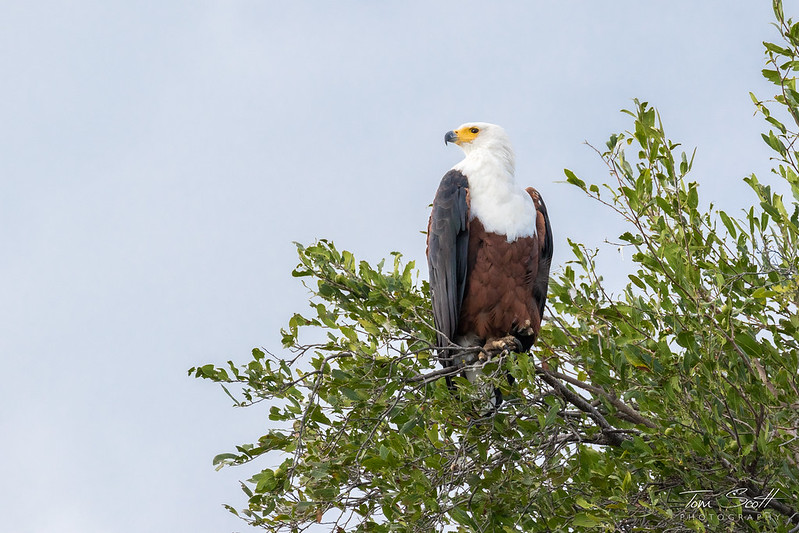 Fish Eagle, Chobe National Park, Botswana by Tom Scott, on Flickr
Fish Eagle, Chobe National Park, Botswana by Tom Scott, on Flickr
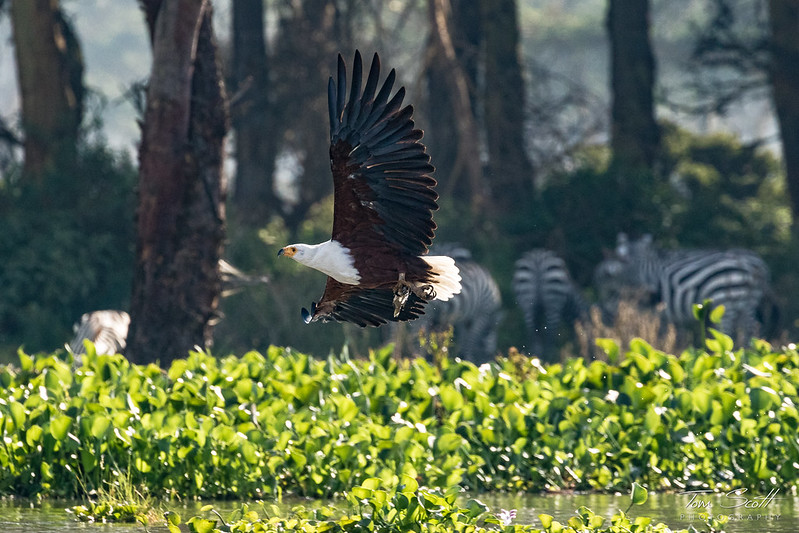 Fish Eagle, Lake Naivasha, Kenya by Tom Scott, on Flickr
Fish Eagle, Lake Naivasha, Kenya by Tom Scott, on Flickr
Even shot this with a 70D and 55-250mm
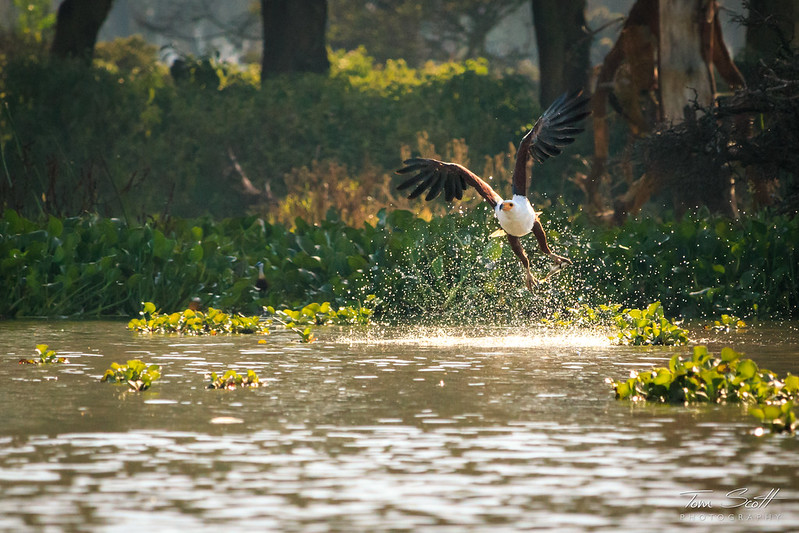 Fish Eagle, Lake Naivasha, Kenya by Tom Scott, on Flickr
Fish Eagle, Lake Naivasha, Kenya by Tom Scott, on Flickr
Probably the most bang for buck/weight saving combo ive ever used. IQ is excelent for a £100 lens. What the GF took with her and went toe to toe with me. Although the 100-400mm has its advantages.
The one reason I wouldnt take the 150-600mm is the fact its beyond dusty. At the end of every safari all the gear, me etc absolutely head to toe. The 100-400mm didnt come home with one bit of dust. I took the tammy out for an afternoon at a zoo to test it and it came back full.
The thing is the Canon lenses are built to take the hammer one thing I really like about them.
Many people think you need the biggest lenses you dont. Animals except a few are all within framing with 600mm. Birds are always a difficult one but again I had no issues except small birds like bee-eaters or lilac breasted rollers etc but they are everywhere so its not like you have to go far to find them.
I didnt find myself needing the 2.8, and its far too shallow for most subjects. Plus you have to think about the weight. The nice thing about the 70-200mm is you can put a 1.4 and get a good 280 F4 or 450 F4 on crop, I used to shoot primarily with the 70-200mm with a 2x and got some of my favourite shots with it.
The 100-400mm is just the best of both for me. Want 600mm stick a 7D on it want better IQ at lower light stick it on a full frame body. Essentially what I did, most of the time left it on the 7D and put a 24-105 on the 5DMKIII. There wasnt any time I needed more reach except once where a leopard was in a tree but the atmospheric issues with heat rising ruined the shot anyway.
 Fish Eagle, Chobe National Park, Botswana by Tom Scott, on Flickr
Fish Eagle, Chobe National Park, Botswana by Tom Scott, on Flickr Fish Eagle, Lake Naivasha, Kenya by Tom Scott, on Flickr
Fish Eagle, Lake Naivasha, Kenya by Tom Scott, on FlickrEven shot this with a 70D and 55-250mm
 Fish Eagle, Lake Naivasha, Kenya by Tom Scott, on Flickr
Fish Eagle, Lake Naivasha, Kenya by Tom Scott, on FlickrProbably the most bang for buck/weight saving combo ive ever used. IQ is excelent for a £100 lens. What the GF took with her and went toe to toe with me. Although the 100-400mm has its advantages.
The one reason I wouldnt take the 150-600mm is the fact its beyond dusty. At the end of every safari all the gear, me etc absolutely head to toe. The 100-400mm didnt come home with one bit of dust. I took the tammy out for an afternoon at a zoo to test it and it came back full.
The thing is the Canon lenses are built to take the hammer one thing I really like about them.
Upvote
0
tomscott said:TBH for Africa I didnt need my 70-200mm I wasnt there for 2 weeks was there 3 months and came across pretty much all situations you would find yourself light wise.
Many people think you need the biggest lenses you dont. Animals except a few are all within framing with 600mm. Birds are always a difficult one but again I had no issues except small birds like bee-eaters or lilac breasted rollers etc but they are everywhere so its not like you have to go far to find them.
I didnt find myself needing the 2.8, and its far too shallow for most subjects. Plus you have to think about the weight. The nice thing about the 70-200mm is you can put a 1.4 and get a good 280 F4 or 450 F4 on crop, I used to shoot primarily with the 70-200mm with a 2x and got some of my favourite shots with it.
The 100-400mm is just the best of both for me. Want 600mm stick a 7D on it want better IQ at lower light stick it on a full frame body. Essentially what I did, most of the time left it on the 7D and put a 24-105 on the 5DMKIII. There wasnt any time I needed more reach except once where a leopard was in a tree but the atmospheric issues with heat rising ruined the shot anyway.
Even shot this with a 70D and 55-250mm
Probably the most bang for buck/weight saving combo ive ever used. IQ is excelent for a £100 lens. What the GF took with her and went toe to toe with me. Although the 100-400mm has its advantages.
The one reason I wouldnt take the 150-600mm is the fact its beyond dusty. At the end of every safari all the gear, me etc absolutely head to toe. The 100-400mm didnt come home with one bit of dust. I took the tammy out for an afternoon at a zoo to test it and it came back full.
The thing is the Canon lenses are built to take the hammer one thing I really like about them.
So you were 3 months in Africa and took with you a 100-400 II and a 24-105 with a 7DII and 5DIII, and that covered all the possible situations?
I wanted to get the Sigma 150-600 Sport because of the weather sealing and good construction and the 70-200 f2.8 IS to complement in the second camera and go with those lenses plus the 100 f2.8 macro and the 17-40. Today I have 7D and 1DIV (should be nice to change to 7DII and 1Dx, but probably wont be able to do it).
In Galapagos the 100-400 II is the ideal choice (as you can get very close), but I went with my Canon 400 f5.6L and ended up getting good images too.
For Costa Rica the 150-600 C worked fine even when it was slow (f6.3) and suffered the bad weather conditions.
As I never went to Africa I was curious on your experience. In the past I've taken 2 cameras but only 1 long lens with me.
Upvote
0
My one safari in Africa used the 7D + 70-200mm f/4 L IS, which Photozone described as "Every now and then EOS, the goddess of mercy, seems to speak to the Canon lens designers and this time they listened carefully. The Canon EF 70-200mm f/4 USM L IS may well be the very best tele zoom on the market today - it is certainly the best Canon zoom lens tested locally to date.". But, to agree with Tom, the 55-250mm is fantastic. My copy of the STM is sharper than the f/4 L at 200mm and carries through to 250mm, so I have just sold the L and use the STM on the M5. I think the 100-400mm II is the best safari lens ever, being able to cope with close ups and distance of animals, and it is sharper than the 70-200mm L IS.
Upvote
0
tomscott
Photographer & Graphic Designer
piovanil said:tomscott said:TBH for Africa I didnt need my 70-200mm I wasnt there for 2 weeks was there 3 months and came across pretty much all situations you would find yourself light wise.
Many people think you need the biggest lenses you dont. Animals except a few are all within framing with 600mm. Birds are always a difficult one but again I had no issues except small birds like bee-eaters or lilac breasted rollers etc but they are everywhere so its not like you have to go far to find them.
I didnt find myself needing the 2.8, and its far too shallow for most subjects. Plus you have to think about the weight. The nice thing about the 70-200mm is you can put a 1.4 and get a good 280 F4 or 450 F4 on crop, I used to shoot primarily with the 70-200mm with a 2x and got some of my favourite shots with it.
The 100-400mm is just the best of both for me. Want 600mm stick a 7D on it want better IQ at lower light stick it on a full frame body. Essentially what I did, most of the time left it on the 7D and put a 24-105 on the 5DMKIII. There wasnt any time I needed more reach except once where a leopard was in a tree but the atmospheric issues with heat rising ruined the shot anyway.
Even shot this with a 70D and 55-250mm
Probably the most bang for buck/weight saving combo ive ever used. IQ is excelent for a £100 lens. What the GF took with her and went toe to toe with me. Although the 100-400mm has its advantages.
The one reason I wouldnt take the 150-600mm is the fact its beyond dusty. At the end of every safari all the gear, me etc absolutely head to toe. The 100-400mm didnt come home with one bit of dust. I took the tammy out for an afternoon at a zoo to test it and it came back full.
The thing is the Canon lenses are built to take the hammer one thing I really like about them.
So you were 3 months in Africa and took with you a 100-400 II and a 24-105 with a 7DII and 5DIII, and that covered all the possible situations?
I wanted to get the Sigma 150-600 Sport because of the weather sealing and good construction and the 70-200 f2.8 IS to complement in the second camera and go with those lenses plus the 100 f2.8 macro and the 17-40. Today I have 7D and 1DIV (should be nice to change to 7DII and 1Dx, but probably wont be able to do it).
In Galapagos the 100-400 II is the ideal choice (as you can get very close), but I went with my Canon 400 f5.6L and ended up getting good images too.
For Costa Rica the 150-600 C worked fine even when it was slow (f6.3) and suffered the bad weather conditions.
As I never went to Africa I was curious on your experience. In the past I've taken 2 cameras but only 1 long lens with me.
The first time I went traveling I spent 2 months across South America and 3 months across North America. I wanted to travel light so I took:
5DMKIII
16-35mm F2.8 MKII
24-105mm F4 L
70-300mm L
iPad mini
For most of the trip this was fine except when it came to wildlife which wasnt the main reason for the trip unlike my second. But I did go to the colca canyon to see the condors and got no where near and spent 2 weeks in the peruvian Amazon, tambopata.
For the amazon it was a struggle although I still got some great images it just wasnt ideal. But my back was very happy for it. One small backpack with one section at the bottom with all my gear and the top half for supplies. Small and light. The problem I found was I had to shoot SML jpg to the SD card slot to transfer to the ipad so no redundancy and of corse no way to attach a HDD to the ipad so I had to buy a Colourspace UDMA HDD card reader device which was expensive and not really very good. The ipad I took was a first gen mini retina and its colour accuracy was awful. I was editing the images and posting and people were telling me they looked awful although on screen looked great.
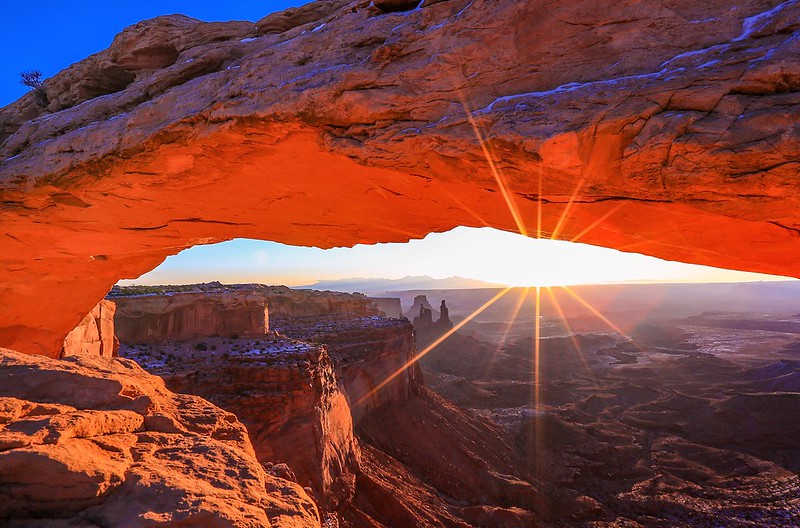 Mesa Arch, Canyonlands, Utah by Tom Scott, on Flickr
Mesa Arch, Canyonlands, Utah by Tom Scott, on FlickrIt was also a pain that I then would have to edit the image again when I got home as the SML jpgs were really small files. It was super convenient tho and did the job of getting images out.
For my trip across Africa and SE Asia, my main concern was wildlife and knew I would be on an overland truck for most of the trip so weight wasnt too much of a concern but I still would need to carry everything between stops.
The gear I took with me
5DMKIII
7DMKII
16-35mm F2.8 MKII
24-105mm F4 L
100-400mm MKII L
1.4x MKIII
11inch Macbook air
2x 4tb seagate HDD
1x 1TB SSD for editing
GF brought (seperate bag)
70D
18-135mm EFS
55-250mm EFS
I was backpacking so had this in a Fstop Loca Lite which was about 15-16kg in total. Because it looks like a backpack I never needed to weigh it at check in and carried it no problem as a carry on believe it or not. I also had a big bag I had my clothes and supplies etc in a 60L bag which was about 18-20kg.
This covered me for 90% of situations. The only thing I missed out on was macro but the 100-400mm MKII has a great close up feature so you can use that in a pinch.
The thing about Africa and if you read people get funny about which lens to use at which locations as some are quite wide and open and others not so. It also depends on the time of year, if you go in the summer then its very lush (depending where you are) much harder to see animals, in the fall its more arid and easier to spot animals. I was there in january-march and it was perfect. The advice I read said anything from only a 70-200 all the was up to 800mm.
I went to every major national park across southern Africa from the arid Etosha and the very green lush Ngorongoro crater and pretty much saw all seasons, wet, arid and lush. What I found was that the animals are super used to people and are not scared at all, infact more curious and a lot of the time I had more reach than I needed for mammals. For birding I think I had about enough with 600mm equivalent. The other thing is that Safari isnt really like shooting a sports event... All the animals are generally super chilled. The action happens in the morning and the evening but in the whole time I was there and the 50+ safaris I went on I didnt really see and chases. Most of the time you happen upon these animals chilling in the shade, so although I put loads of emphasis on the 150-600mm not being the best at tracking moving subjects I didnt shoot a lot of movement, except BIF.
Im glad I didn't just take a 70-200mm and im glad I didn't take a prime, the subjects were all over the place so the zoom was really useful. A lot of the time I found myself switching to wider lenses to capture the environment.

The other thing you have to bare in mind like I spoke about earlier is the atmospheric problems, once you go over 600mm all the images will be OOF due to heat rising. The only thing you can do is get closer. Its a real issue especially on the plains or the desert. It was pretty rare as you do get so close. The two in memory were a leopard in a tree because we physically couldn't get closer. I put the 1.4 on the 100-400mm on the 7DMKII to make 900mm. I got the image but it certainly isnt technically the best or the sharpest because of the heat and distance. But I got the image.

The other was a black rhino that was heading off into the distance in the opposite direction we were traveling in.
The thing is the tammy is a big lens, the sigma sport is even bigger and heavier. This is the reason I bought the 100-400mm because its sharper than all the lenses previous. On two bodies FF + crop which dont take not much extra room you can have the best of both worlds. Thing is its super convenient with those two bodies it covers the same range as having the 70-200mm and the 150-600mm except with the 600mm on crop but from my experience I wasn't happy with the IQ from that combo it was super soft and found cropping was a better solution. Just pushed the lens too far with the 150-600mm on a crop body being over 1300mm.
The only negative is you loose the F2.8 but F5.6 on a FF body up to 12800 ISO I was getting some good results. The only time I struggled was on night safaris where they used an infrared light but even with F2.8 it would be a struggle.
This was one of those times, in the middle of the Namib desert it was around 3am and these zebra were coming for a midnight drink and I stayed up to watch. The actual scene was black to the eye apart from the light at the water hole.
I also edited this on the road and it has FB compression so isnt amazing. This is 5DMKIII 100-400mm F5.6 at 25600ISO

TBH the other issue is on safari the Defenders or landcruisers are not big and unless you have private safaris will be full of people. You will really struggle to move the 150-600mm around as its probably half the length of the wheel base. I was lucky I was on a private safari and we had me and 4 friends who were really happy for me to be moving around. The action moves so fast you will want to be right, left, front and back and the 100-400 is so convenient in this situation because its small and fairly light and you have so much range.
Basically left the 100-400 on the 7DMKII and a 24-105 on the 5DMKIII and kept swapping around as and when I needed. One morning and evening safaris I used the 100-400mm on the 5DMKIII. TBH the 7DMKII does pretty well too at high ISO.
This is 6400ISO with the 7DMKII

Again has FB compression and was edited on the road so could have done a better job.
Im sure as you know from being in Costa Rica through the rain forrest that its not easy trekking. Those mountain gorillas in Uganda we trekked though the Biwindi NP and it was 100% humidity and about 35deg C it was torture, no trails just cutting though with machetes. Took us 6 hours to get to them, having a little bit less weight was a god send.

If your on a small trip say 2-3 weeks and have a good base then I would say take what ever you feel comfortable taking. If not then its worth saving your back and condensing gear. The other variable to take into account was that I knew I had a lot of Safaris so I wasnt ever disappointed, if we didn't see something on one we would at another and we tended to do 2-3 a day when in the national park. i know not everyone has this luxury so some people just take everything.
The other thing im really glad I took was the 16-35mm I got some incredible images like MT bromo volcanoe erupting. Our guide decided it was fine to take us up on the rim and there was a 25km exclusion zone (we had no idea) and it errupted as we stood on the rim. One of the most incredible but terrifying experiences.

Later that evening I went to a viewpoint and go this...

Believe it or not this was shot with the camera on a Gorilla pod attached to a metal fence.
Also some beautiful views like Fish river Canyon

Spitzkoppe

MT Batur

to name a few and tha I have images at hand.
The 100-400 is just such a good performer and with 2 bodies you have a very very versatile lens that is about as sharp as you can get at this price point and is lightweight. It also performs super well with tele converters.
It does depend on your situation. If I had the money and the space and probably a porter to carry it all I would have 3 bodies, 400mm DO II, 100-400mm, 24-105, 2x and 1.4. It just not feasible.
The other thing you have to worry about is safety and obviously with all this gear you are a target. I got by fine with just street smarts but it is something to consider. I bought metal wire security cables that I could padlock and put them through the Zips. Obviously isnt going to stop someone stealing everything but its a deterant and will certainly take more time to get to the gear..
The nice thing about the Loka is it has an internal camera compartment that has its own zip bag and I then had Carabeana that attached it to the internal metal frame of the bag. So if someone slit the bag they wouldn't be able to pull the gear out without me or someone noticing.
Obviously I was backpacking so this is maybe more specific to that kind of traveling.
Upvote
0
tomscott
Photographer & Graphic Designer
AlanF said:There are problems with f/2.8s. The 300mm/2.8 II and the 400mm/2.8 II are the sharpest lenses on the block. I have just sold my 300mm/2.8 II as I haven't used it since buying the 400mm DO II, and Art Morris says in his blog that the price of used 300mms has dropped since the 400mm II has come out as birders prefer it. 300mm is too short.
It might be a surprise, but there is little advantage in light-gathering f-stop using a 300mm at f/2.8 compared with a 400mm at f/4 when you are cropping. You get nearly as much light going through the 400mm/4 as the 300mm/2.8 as they have similar sized front elements. If you double the iso with the 400mm to get the same shutter speed as an f/2.8, and then downsize 1.4x, you end up with very similar signal to noise.
The 400mm/2.8 II is too heavy to hand hold for birds in flight. On my puffins in flight trip, I was able to swing around quickly with my 5DIV and 400mm/4 and get shot after shot whereas the person next to me with a 1DX and 400/2.8 on a tripod was too slow. For static shots, the 400/2.8 was the winner.
Would love a 400mm DO II they look lovely, small (for the focal length and in comparison to others) and amazingly sharp. For me just a bit too big for travel and price restrictive. Love the versatility of the zoom. I think the versatility of a zoom is worth the stop penalty.
One day maybe!
Would love to see some images. Puffins are one of my favorites. I have a yearly Jaunt to the Farne islands in the UK to see them.
AlanF said:My one safari in Africa used the 7D + 70-200mm f/4 L IS, which Photozone described as "Every now and then EOS, the goddess of mercy, seems to speak to the Canon lens designers and this time they listened carefully. The Canon EF 70-200mm f/4 USM L IS may well be the very best tele zoom on the market today - it is certainly the best Canon zoom lens tested locally to date.". But, to agree with Tom, the 55-250mm is fantastic. My copy of the STM is sharper than the f/4 L at 200mm and carries through to 250mm, so I have just sold the L and use the STM on the M5. I think the 100-400mm II is the best safari lens ever, being able to cope with close ups and distance of animals, and it is sharper than the 70-200mm L IS.
Completely agree! Was so chuffed with the images she took with the combo, shes not a really a photographer but she got some incredible images and never complained with the weight etc. She mostly shot video which came out really well.
Upvote
0
One thing is clear, we are all having incredible fun with our lenses. We are so lucky to have such a choice of excellent light to medium weight telephotos that just about cover everything from close ups of beetles to birds daring past us close and far.
Upvote
0
piovanil said:Want to know what happened on the 4th second when it moved? Not one of my best moments!

Not one of you best moments? This sir, is one of your finest moments! ;D Maybe I'm just odd, but there's something about this one that I just love - it looks like painted brushstrokes
I wish I could have such wonderful accidents
Upvote
0
Quirkz said:piovanil said:Want to know what happened on the 4th second when it moved? Not one of my best moments!
Not one of you best moments? This sir, is one of your finest moments! ;D Maybe I'm just odd, but there's something about this one that I just love - it looks like painted brushstrokes
I wish I could have such wonderful accidents
Glad you like it! I do like the picture, but not very fond of obtain the results "by accident"!. I wanted a freeze and sharp Quetzal, but got something very different.
If I would wanted that surrealist painted movement I would have been very happy!.
But I had both, so should not be so bad.
Here I have 2 pictures were the light also was very bad and the small birds were moving a lot, but was able to take the picture anyway. The monopod helped and it was a matter of shoot when the bird stood quiet for a second.
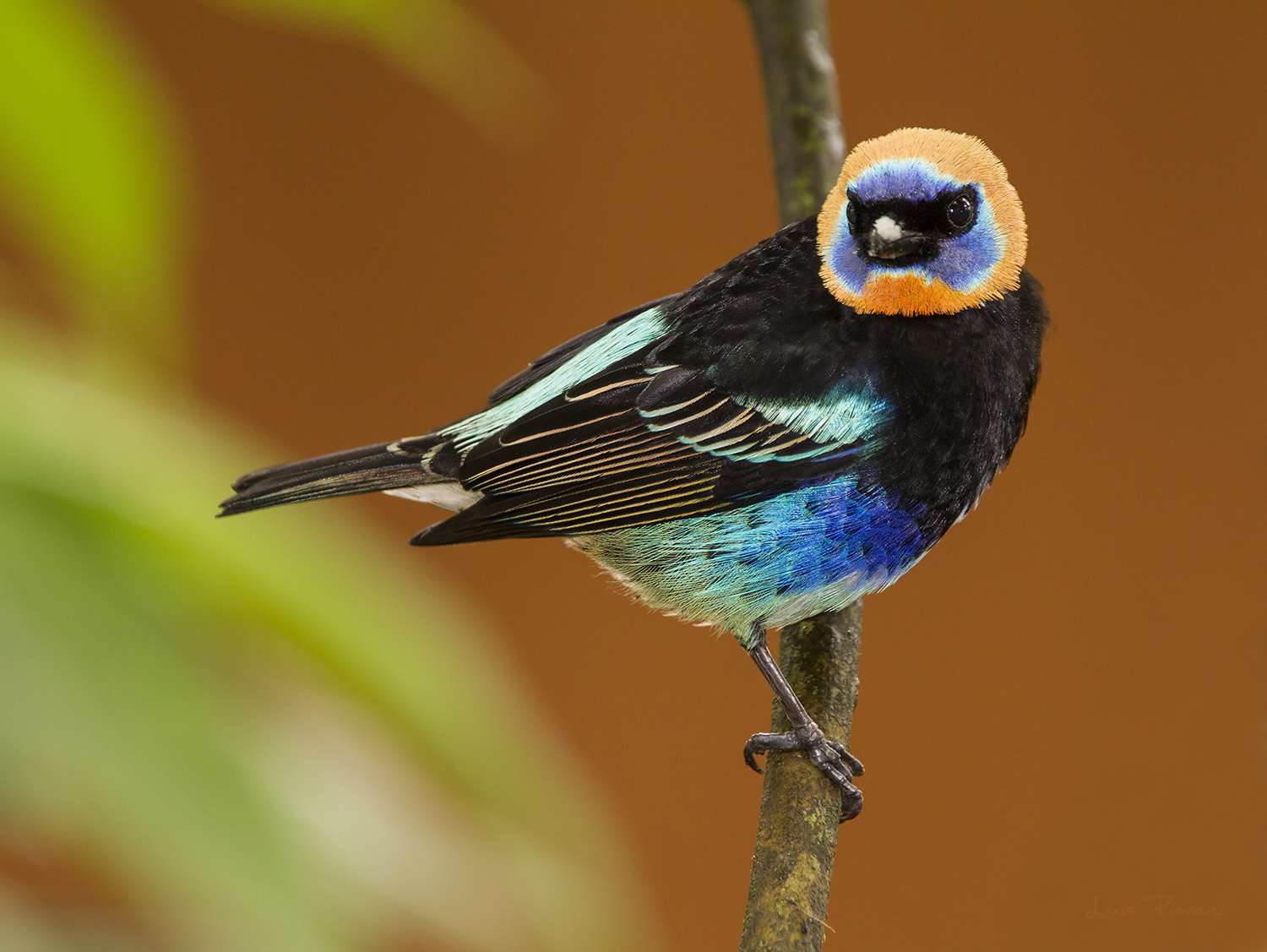
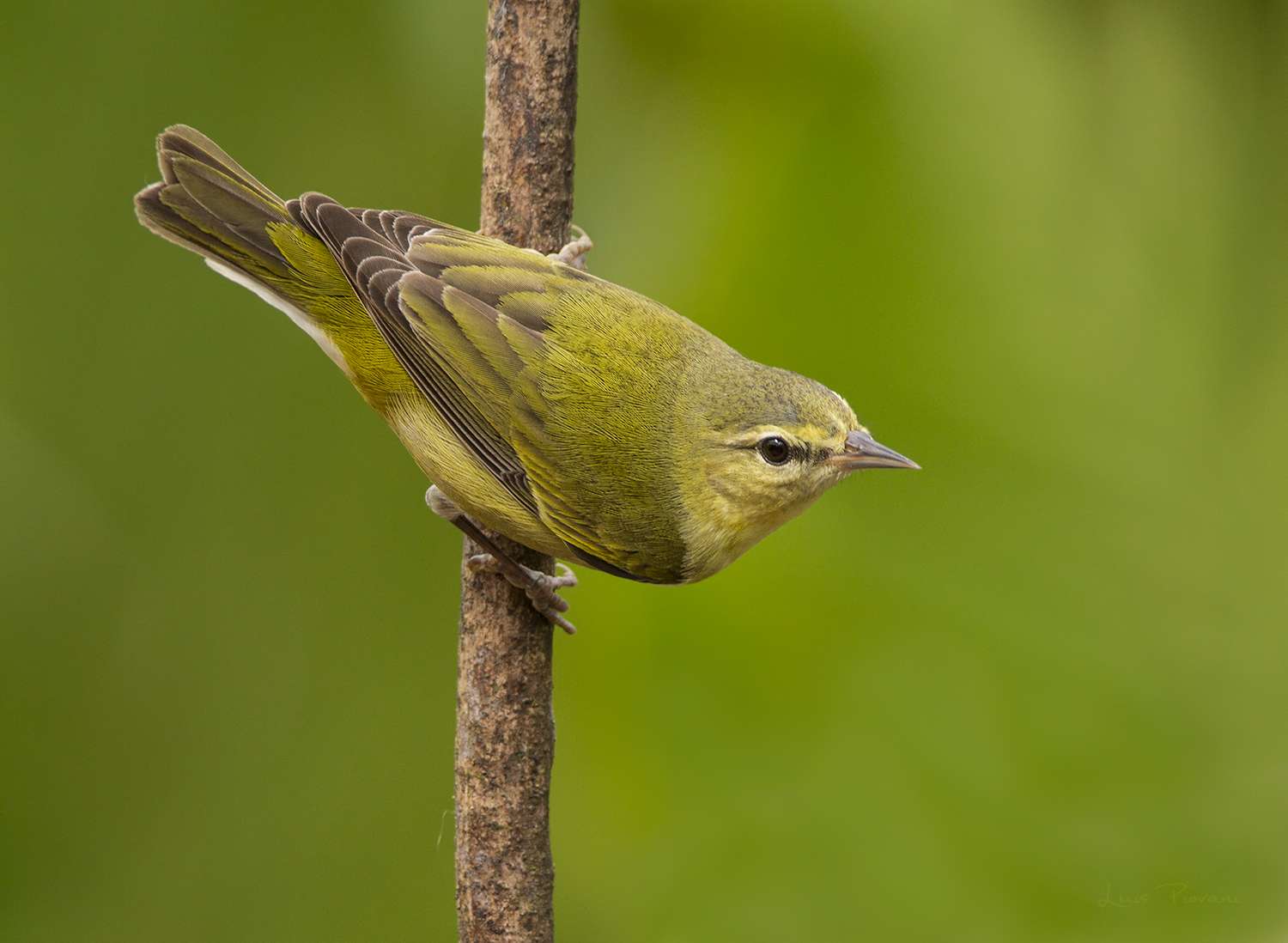
Regards
Upvote
0
I just recently acquired a new 100-400 II and truth be told, I am not overly impressed so far. Focus seems a little slow and a bit hit and miss (this is on a 5D3) and quality even on sharp shots is not brilliant in my opinion. It is conceivable I had unrealistic expectations. My previous rig was the 300 II with a 2x tele.
 Emma Gray's Forest Lizard (Calotes emma) by Kris Bell, on Flickr
Emma Gray's Forest Lizard (Calotes emma) by Kris Bell, on Flickr
 Emma Gray's Forest Lizard (Calotes emma) by Kris Bell, on Flickr
Emma Gray's Forest Lizard (Calotes emma) by Kris Bell, on Flickr
Upvote
0
The 300/2.8 II is one of the best lenses available. My 300/2.8 + 2xTC gave some remarkable shots with excellent acutance and sets a very high standard that the 100-400mm II +1.4x can't match. However, the 300/2.8 + 2xTC is pretty slow focussing so if the 100-400mm II is slower, then something is wrong with either the lens or the camera.
Upvote
0
D
Deleted member 378664
Guest
piovanil said:Here I have 2 pictures were the light also was very bad and the small birds were moving a lot, but was able to take the picture anyway. The monopod helped and it was a matter of shoot when the bird stood quiet for a second.
Regards
Where did you focus at on these two pictures. It seems, if you focused on the eyes of the birds, that the focus is slightly shifted to the mid of the bird bodies. The feathers in the middle of the body are looking sharper than the eyes.
Upvote
0
AlanF said:The 300/2.8 II is one of the best lenses available. My 300/2.8 + 2xTC gave some remarkable shots with excellent acutance and sets a very high standard that the 100-400mm II +1.4x can't match. However, the 300/2.8 + 2xTC is pretty slow focussing so if the 100-400mm II is slower, then something is wrong with either the lens or the camera.
Hi Alan, thats interesting. I havent done anything 'scientific' in terms of comparisons and I havent used it enough to form a fully rounded opinion but I would say focusing so far has been no better than 300+2x. How would you expect IQ to compare between the 300+2x and bare 100-400 II?
Upvote
0
krisbell said:AlanF said:The 300/2.8 II is one of the best lenses available. My 300/2.8 + 2xTC gave some remarkable shots with excellent acutance and sets a very high standard that the 100-400mm II +1.4x can't match. However, the 300/2.8 + 2xTC is pretty slow focussing so if the 100-400mm II is slower, then something is wrong with either the lens or the camera.
Hi Alan, thats interesting. I havent done anything 'scientific' in terms of comparisons and I havent used it enough to form a fully rounded opinion but I would say focusing so far has been no better than 300+2x. How would you expect IQ to compare between the 300+2x and bare 100-400 II?
I have sold both my 300/2.8 and 5DIII but I still have test results as well loads of shots. The combination is particularly good. The 300x2 has 50% more reach than the 100-400mm II and it shows - it has 50% more resolution and not much less acutance. I am not without some remorse selling the 300mm, but I have the 400mm DO II and can't justify having both. The advantages of the 100-400mm II are simply it's a zoom, it is far lighter and focusses very close. It's my travel lens, and I like it on the 5DSR.
Upvote
0
Great post and I know its old but.... I have a somewhat opposite question. I currently have the Canon 100-400 Mk I (on a 7D mkI). Yes both 1st generation. I really like this lens/body combination. However, I'm now looking for a more range and of course better low light capability (I photo only birds).
So... without spending $11K what would be the next lens in addition to the 100-400 MkI
FYI: I also have the 1.4x TC version 1 but rarely ever use it
Thanks,
Greg
So... without spending $11K what would be the next lens in addition to the 100-400 MkI
FYI: I also have the 1.4x TC version 1 but rarely ever use it
Thanks,
Greg
Upvote
0
unfocused
Photos/Photo Book Reviews: www.thecuriouseye.com
birdforthought said:...So... without spending $11K what would be the next lens in addition to the 100-400 MkI
FYI: I also have the 1.4x TC version 1 but rarely ever use it...
Your choices for lenses would be either of the Sigma 150-600s, the Tamron 150-600 or the Canon 100-400 II. There is really nothing else in the under $2,500 range. If your upper limit is higher, you could look at the version I of either the Canon 500mm or Canon 600mm or the Sigma 500mm f4 Sport.
I have the Sigma C and it is a decent lens, although I generally prefer the Canon 100-400 II.
You've hit on the dilemma many people face.
APS-C gives you reach, but not low-light performance (Although both the 7DII and the 80D are much improved over the original 7D)
For low-light, the best compromise is probably the 5DIV, which has 7fps (not as good as the 7DII or 1DxII, but certainly usable). Of course, you lose some reach, but with 30 mp, you have some room to crop.
You might also want to upgrade the extender to the III version. Either the 80D or 5DIV, will give you multiple autofocus points at f8.
If I were in your shoes and I didn't want to buy or carry around one of the older big whites (weight being the major difference between the older and newer versions), I'd update the 100-400 and update the 7D, with a 5DIV or an 80D or 7DII (depending on budget). I believe I see significant improvement between the 100-400 versions I and II and you can sell the version I to make the switch a little less painful. Both the Sigma and Tamron 150-600s go on special regularly, so you could add one of those to your kit as an additional option.
In short, there is no ideal solution, but updating your kit might be the place to start.
Upvote
0
birdforthought said:Great post and I know its old but.... I have a somewhat opposite question. I currently have the Canon 100-400 Mk I (on a 7D mkI). Yes both 1st generation. I really like this lens/body combination. However, I'm now looking for a more range and of course better low light capability (I photo only birds).
So... without spending $11K what would be the next lens in addition to the 100-400 MkI
FYI: I also have the 1.4x TC version 1 but rarely ever use it
Thanks,
Greg
I think your best bet is a 150-600 Sigma. Without spending big, I think 600/6.3 is as much reach as you can get, with the benefit of it being very sharp at 600.
The reach is not going to be a lot longer than your 400+1.4, but 6.3 autofocuses better and is more usable than f8. If you like to shoot birds really close in the 100-400L2 is a princely lens that is a big improvement over the mark 1, including a much closer MFD.
Upvote
0
Similar threads
- Replies
- 3
- Views
- 3K
